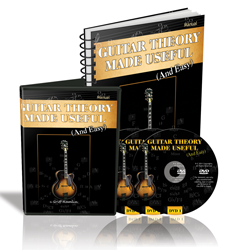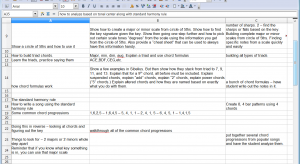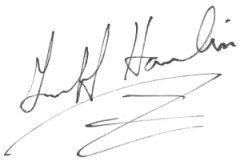Discover The Fastest And Easiest Way To Get The Guitar Theory You Need Without The Extra Baggage You Don't
Now you can get in just a few weeks what takes most people years to learn - how to analyze and deconstruct music so that you can solo over anything, write your own songs, increase your learning speed, and just plain understand everything you play better than you did before...
- Have you ever wished you could improvise freely over any song that gets put in front of you at the drop of a hat?
- Have you ever felt like you would be able to learn a lot faster if you actually understood why your guitar teacher asks you to practice the things he does?
- Have you ever wished you could learn songs faster than you do now? What about being able to remember hundreds, if not thousands of songs without having music in front of you?
- Have you ever wanted to write your own songs but didn’t know where to start or what to do next?
- Have you ever wished you could listen to a song and be able to pick out what chords to play by ear?
You’ve probably known other guitar players that can do all of these things… and if you don’t, well you know me 🙂
 … And you may have wondered what magic power it is that allows them to do the seemingly impossible…
… And you may have wondered what magic power it is that allows them to do the seemingly impossible…
You might have even asked some of them to find out what their secret was (and they may not have been able to tell you)
But I can assure you, the power is not some sort of magic. In fact, it’s simple, and anyone can learn it. I’ve personally taught it to hundreds of private students over the years.
What is it you ask? Simple. It’s knowing music theory.
Now before you roll your eyes and close this page, you need to understand that if you’ve heard of music theory, and maybe even tried to learn it – you’ve likely gotten started and given up pretty fast.
But I can assure you, it’s not your fault.
Theory is not hard to learn, but it is hard to teach… and I know this because I’ve spent my entire professional career teaching it!
You probably have a lot in common with most of my students – you’ve likely heard of music theory, and you may have heard that you need it. But has anyone ever told you why you need it?
That always seems to be the big missing link. I hear it all the time “If I could only learn music theory I’d be so much better on guitar. Do you know where I can learn it?”
That question is a recipe for disaster because it’s the wrong question based on the wrong information. When I have a student that asks that question, it usually takes a little time to undo it. But once it’s undone, they see that music theory is not some big mystical monster that must be conquered as a rite of passage to learning guitar.
In fact, Music Theory is nothing more than a tool. It’s a simple set of guidelines and common practices for how music works.
A Self Proclaimed “Theory Geek”…
Yes, that’s me. I was one of the few high school and college music students that actually looked forward to theory class. I loved it. So much so that I used to basically give myself extra homework!
I would not only do what the teacher assigned, but I would also take other songs that I knew how to play on the guitar, and I would analyze and deconstruct them the same way.
So of course, when I was teaching my own students, I passed on my love of music theory to them, right? Wrong!
Turns out, most of my students didn’t want to know all about Neopolitan chords and how an Italian Augmented 6th is different from a German Augmented 6th (it’s all in the resolution, by the way.) They just wanted to know enough to actually do stuff with it (go figure.)
Things had to change…
Lucky for them, I’d spent a lot of time applying the theory you learn in school, which revolves around old music (really old, like 17th century) and worked on applying it to modern music (like, less than 50 years old.)
But the tricky part was separating the wheat from the chaff, so to speak… In other words I had to figure out how to separate the information that was useful from the information that really didn’t matter.
But more importantly, I had to get it all in the right order…
And that’s how “the list” was born…
Now I realize that this is going to make me seem really over the top, but I actually kept a spreadsheet of all the different theory topics on my laptop while I was teaching. I called it “the list” and I used it with every student to make sure I gave them the right things in the right order.
But this was no ordinary list… no way – this list was tuned and refined over many years and many students.
It was great, every time I’d hit a little stumbling block where I realized I’d done things out of order, I’d fix it and never make that mistake again.
After a few years, I had streamlined it and honed it to the point where I could get through everything my students would need to know in just a few weeks instead of years like college theory courses.
So, what is it that you can do with theory?
Music theory is the “rulebook” for music. With even just the basics of theory under your belt you can:
- Look at a set of chords and determine what key they are in and what scales you would use if you want to solo over them.
- Learn songs by number instead of by chord and remember them 10 times faster than your old way.
- Remember way more songs that you can now because you’ll see the similarities between the songs. When you realize that 10 different songs have the same chord progression just in different keys, those 10 songs all seem like 1 to you… it’s awesome.
- Transpose (change keys) effortlessly. Let’s say you’re doing a song in one key, but one day you have a different singer who likes a different key – no problem for you. Or let’s say you can play a song by one of your favorite artists but you can’t sing it because it’s too high. With theory you can change the key down to a key you can sing in and play the song easily.
- Find notes easier on your guitar. When you know how notes work, it’s really easy to find notes you don’t know using notes you do know.
- Play the “sweet notes” of the chords when you solo because you know what the chord tones are and how to find them.
- How “the formula” works for every scale and chord on the planet. If you know the formula you know the chord or scale.
- How to literally create chords out of thin air. See a chord you don’t know? Just create a fingering and off you go.
- Listen to songs on the radio and know what each chord is by being able to hear its function. Until you actually feel this in action it’s hard to imagine, but you can literally hear and feel the chords doing their job when you know what their job is.
- Pick out melodies fast because you know what the likely notes are. Imagine knowing that if you sit down to pick up something from a recording, you can eliminate over half of the notes before you even start… do you think it would be a little easier? You bet!
And really, those are just some of the things theory can do for you. When you understand music, you learn faster, which makes it more enjoyable, which makes you want to do it even more.
It’s the classic ascending spiral of success bringing more success…
So what’s in Guitar Theory Made Useful (and easy)?
The Guitar Theory Made Useful course is probably what you would expect… 21 lessons divided into 2 or 3 videos each, with explanation both in the video and in the workbook.
The lessons break down like this:
1. The “Concept” video where I walk you through a new concept or technique. I do this using graphics and drawing tools on my computer so you can really “see” how things are done. Here’s an example of the very first “concept” video where we cover what I call your “mental model” of notes and how they work. This lesson lays the groundwork for the rest of the lessons. Notice that there are some exercises for you to work at the end of this.
2. The “Answers” portion where I walk you through the answers to the exercises at the end of each lesson. I encourage you to watch this video first one time, then go through the exercises yourself and see if you can do them. Here’s an example of an “answers” video where we’re talking about building major scales using half steps and whole steps like you learned in the first concept video:
3. Finally, in many cases there is also a “practical” video where I show you how to apply the concept from the lesson (or the last few lessons) to your guitar.Here is an example of how you could build those major scales from the last video on your guitar:
The Blow-By-Blow Rundown…
1 – The Mental Model of notes and how they work. I believe this to be the critical foundation step that every other theory course I looked at left out. They all seem to assume that you already really know how notes work and can navigate through them in your head. You probably can’t (at least in my experience) if you’re new to this.
2 – How to read notes on a staff. This is basically for the sake of completeness because you really don’t have to read music much in the real world, or for anything we do in the course. But it is nice to know and does come in handy once in a while.
3 – Major keys and scales – how to build them and figure out what notes are in them. This is the grand-daddy of just about everything you do so take your time here.
4 – Key Signatures and a great tool call the Circle of 5ths. This is more “how to build scales” using the Circle instead of whole steps and half steps and allows you to go even faster.
5 – Intervals, the distances between notes. You can use intervals for a variety of things – harmonizing melodies, building chords, and even for writing your own music.
6 through 8 – This is where all of the “how to build chords” is handled. Imagine how cool it would be to just be able to look at the notes on your guitar as if they lit up and choose a chord out of those notes. Many people ask me how I know so many chords and the truth is that I don’t really, I often make them up as I go when I need them.
9 – Chord progressions and the Standard Harmony Rule. This is where things start to get fun because you learn how songs and chord progressions are put together. You’ll also learn about what’s sometimes called the Nashville Numbering system, and you’ll learn how to transpose keys. A lot comes together all at once.
This is the end of the “basics” and now it’s all about application for a while. In my approach, theory has 2 uses for a guitar player: A) so that you know what scales to use over a given chord progression for soloing B) to learn how chord progressions and harmony work so you can either write your own song, transpose songs, or understand how a song is put together.
No matter how hard I try, I can’t think of any other reason you would need or want to know theory. So all the application boils down to those 2 things.
10 – How to figure out what key a song is in (ie. what scale you can use to solo) given a chord progression. This is my “brute force” method that takes a little time, but always works…
11 – some shortcuts that will by and large reduce the time spent from lesson 10 down to almost nothing. About 70-80% of songs will work with the shortcut. And if it won’t, you have the brute force method to fall back on.
12 – Tonal Centers, Parallel vs Relative scales, and an introduction to modes.
13 – Modal formulas, what they mean and how to play the common “church modes.”
14 – Expanding on the Standard Harmony Rule to include larger (tall chords) and utilizing the modes to determine which notes can be in a chord depending on its function
15 – Using modes to determine the key of a song instead of the old “brute force” method.
16 – minor keys
17 – the harmonic and melodic minor modes. I’ll explain the classical version, but it’s useless for soloing so we work on learning to play the jazz version which is all but useless for soloing instead of entirely useless (I use it once in a great while but you don’t need it and I’ll tell you as much in the course.)
At this point you have more than enough do what you need to do. But there are a few oddball things that come up.
The last few lessons are common ways the rules are broken and how to handle them. This is “force fed experience” basically.
18 – Blues changes – now that you know the rules, it’s fun to look at how they are broken for blues changes.
19 – Secondary Dominant chords (chords that should be minor but instead are major or 7th)
20 – the Beatles iv chord (minor iv chord resolving to the I.)
21 – How to work with progressions full of power chords. Since they aren’t major or minor, they pose some interesting challenges. But by this point you’ll have no trouble with it.
Here’s What To Do Next…
First, understand that as with all of my courses, there is no risk to you when getting your copy of Guitar Theory Made Useful. I offer a 90 day no-hassle refund policy that rarely gets used.

My 90 Day 100% Money Back Guarantee
Get your copy of Guitar Theory Made Useful and sit down with it. Give it a test drive and really put it to work for you. If you are not blown away by what you can achieve with this course any time within 90 days, just let me know and you can have a full and immediate refund, no questions asked.
It’s dead-simple… if you don’t like it, you don’t have to pay for it, and you don’t have to send it back. It’s a no risk deal for you.
Guitar Theory Made Useful Now Comes In 2 Flavors…
You can get Guitar Theory Made Useful shipped to you on 4 DVDs and the printed workbook for $112, or you can get the Digital Download version and not have to wait for the postman to deliver it for $87. And if you choose the DVD version, I’ll throw in access to the digital version as well just in case you want it later.
(If you choose the digital download version please be sure your internet connection can handle several hours of video… the files are large.)
Either way the things I’ve been able to do in my career because I knew music theory would have paid for a course like this 10 times over (in fact, when you think about what I paid the University of Southern California to study theory… I guess it was about 100 times!)
So when you’re ready to get going, choose your package from the choices below. You’ll be taken immediately to the secure checkout area where you can get your copy of Guitar Theory Made Useful today.
To get your complete copy of Guitar Theory Made Useful just click the yellow “Add To Cart” button below with your preferred delivery method. Just as soon as your order is complete you will receive an email with your access instructions to the secure Member Portal so you can be transforming your blues rhythm playing from boring to killer in just a few minutes from now!

This is a one time payment, NOT a subscription. 3 Payment option may be available at checkout.
Remember, this is totally no risk to you. If you don’t like it for any reason within an entire year you can get a hassle-free refund.
But I know that when you see this course and get a taste of how it can improve your playing, you will see that it was the best investment you ever made in your playing.
I wish you all the best and I look forward to hearing your feedback on the course,




